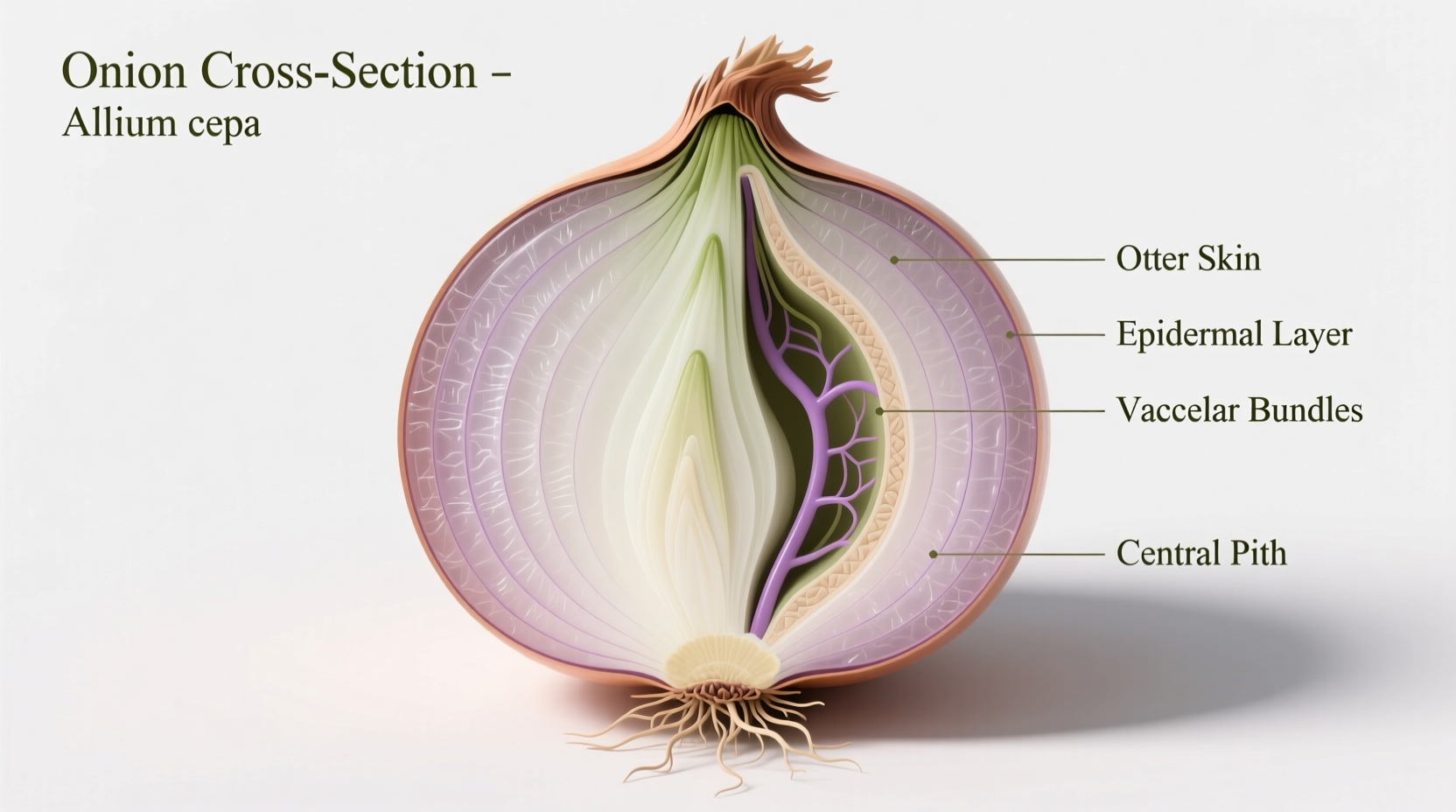Why You Need This Visual Onion Reference
Whether you're identifying produce at the grocery store, studying plant biology, or preparing ingredients for cooking, understanding onion anatomy through accurate imagery saves time and prevents mistakes. This guide delivers precisely what you need: clear visual references paired with practical identification knowledge that goes beyond basic stock photos.
Anatomy of an Onion: What You're Actually Seeing
When examining an onion image, you're looking at a modified underground stem structure called a bulb. Unlike common misconceptions, onions aren't roots but rather storage organs developed from leaf bases. The distinctive layers you see serve specific biological functions:
- Outer dry skin - Protective papery layer that prevents moisture loss
- Fleshy scales - Modified leaves storing nutrients (the edible portion)
- Basal plate - The flat bottom where roots emerge
- Central bud - Future growth point located at the core

Common Onion Varieties Visual Comparison
Not all onions look alike. Recognizing visual differences between varieties prevents recipe failures and ensures proper culinary applications. The USDA Agricultural Research Service documents over 25 commercially significant onion varieties grown in North America alone.
| Variety | Outer Skin Color | Flesh Color | Distinctive Visual Features | Best Culinary Uses |
|---|---|---|---|---|
| Yellow Onion | Tan/brown paper skin | White with yellow tinge | Thick neck, rounded shape | Caramelizing, roasting, general cooking |
| Red Onion | Purple-red skin | Deep purple rings | Vibrant color throughout | Raw applications, salads, pickling |
| White Onion | Pale white skin | Crisp white flesh | Thin skin, slightly flattened | Mexican cuisine, salsas, grilling |
| Shallot | Coppery skin | Light purple flesh | Elongated shape, multiple cloves | Vinaigrettes, delicate sauces |
Identifying Freshness: What to Look for in Onion Images
Food safety experts at the FDA emphasize that visual inspection remains the most reliable method for assessing onion quality before purchase. When evaluating an onion image or real produce, check these critical visual markers:
Fresh Onion Characteristics
- Tight, dry outer skin without soft spots
- Firm texture throughout with no give when gently squeezed
- No visible mold or dark patches on surface
- Minimal neck tissue (thinner neck indicates longer storage life)
Warning Signs of Spoilage
- Dark, sunken areas indicating rot
- Excessive sprouting from the center
- Wet, slimy patches on outer layers
- Mold growth appearing as fuzzy white or green patches
According to Cornell University's post-harvest research, onions stored at room temperature typically maintain visual quality for 2-3 months when kept in mesh bags with proper air circulation. Refrigeration extends shelf life but may cause texture changes in some varieties.
Practical Applications: Using Visual Identification Skills
Understanding onion anatomy through accurate imagery directly translates to better cooking results and food safety. Professional chefs rely on visual identification to select the right variety for specific techniques:
Culinary Decision-Making Based on Appearance
- For caramelizing - Choose yellow onions with thick necks, which contain higher sugar content visible as deeper yellow flesh
- For raw applications - Select firm red onions with vibrant purple rings, indicating peak anthocyanin content
- For long-term storage - Look for onions with completely dry, papery skins and minimal neck tissue
Educational Value for Biology Students
Onion cells provide one of the most accessible plant specimens for microscopic study. The distinctive layered structure visible in cross-section images demonstrates fundamental botanical concepts including:
- Cell wall structure visible under magnification
- Vacuole organization affecting flavor compounds
- Chromoplast development responsible for color variations
Botanical researchers at the University of California note that onion pigmentation follows a predictable developmental timeline. Yellow varieties develop their characteristic color during bulb maturation as flavonoids accumulate, while red onions produce anthocyanins in response to sunlight exposure during growth.
Historical Context: Evolution of Onion Cultivation
Understanding the visual characteristics of modern onions becomes more meaningful when viewed through historical development. Archaeological evidence shows onion cultivation spans millennia:
- 5000 BCE - Earliest onion remains found in Bronze Age settlements across Iran and Pakistan
- 3000 BCE - Egyptians document onion cultivation in hieroglyphs, considering them sacred
- 1st Century CE - Roman agricultural writer Columella describes multiple onion varieties in De Re Rustica
- 16th Century - European colonists introduce onions to North America
- 1940s - Development of day-neutral onion varieties revolutionizes global production
This historical progression directly influences the visual diversity we see in modern onion varieties. The USDA's National Plant Germplasm System maintains over 1,200 distinct onion accessions, preserving visual and genetic diversity for future breeding programs.
Frequently Asked Questions
What causes the different colors in onion varieties?
Onion colors result from different pigment compounds. Yellow onions contain flavonoids like quercetin, red onions produce anthocyanins, and white onions lack significant pigment development. These compounds develop during growth based on genetics and environmental factors.
Why do onions make you cry when cutting them?
When onion cells are damaged during cutting, enzymes convert sulfoxides into sulfenic acids, which then form a volatile gas called syn-propanethial-S-oxide. This gas reacts with moisture in your eyes to create mild sulfuric acid, triggering tear production as a protective response.
How can you tell if an onion has gone bad just by looking at it?
Signs of spoilage include dark, sunken areas; excessive sprouting; wet, slimy patches; and visible mold growth. Fresh onions should have dry, papery skin with no soft spots and feel firm when gently squeezed. The FDA recommends discarding onions showing significant visual deterioration.
Do different colored onions taste different?
Yes, color correlates with flavor profiles. Yellow onions have higher sulfur compounds making them sharper when raw but sweeter when cooked. Red onions contain more sugar and water, giving them a milder raw flavor. White onions have a crisper texture and cleaner onion flavor preferred in Mexican cuisine.











 浙公网安备
33010002000092号
浙公网安备
33010002000092号 浙B2-20120091-4
浙B2-20120091-4